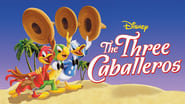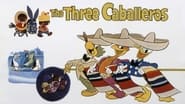PodBill
Just what I expected
Geraldine
The story, direction, characters, and writing/dialogue is akin to taking a tranquilizer shot to the neck, but everything else was so well done.
Kayden
This is a dark and sometimes deeply uncomfortable drama
Staci Frederick
Blistering performances.
Robert J. Maxwell
A lot of things can be said about this movie, but no one can say it is dull. Disney's Donald Duck takes us on a scenic and musical tour of Latin America with episodes in Argentina, Brazil, and Mexico. It begins in a lively tempo and speeds up until it explodes in fireworks at the end.It was a big and necessary hit for Disney at the time but, in a way, it's too bad the film couldn't have been released about 1968, when so many youngsters were doing acid and weed, because this is one trippy movie. It belongs right up there with "2001: A Space Odyssey." A live figure may begin to dance and sing through a cartoon village. Soon Donald Duck joins the dance. Then the lamp posts begin to sway rhythmically, and soon the buildings are bouncing up and down, and then the moon darts from side to side. The viewer may twitch a bit too, because some of the rhythm is very catchy. America gave the world jazz, and Latin America gave us the samba, the conga, the bossa nova, the tango, Carmen Miranda, Heitor Villa-Lobos, and the transplanted Manuel de Falla. And the piñata.It's a pageant of color and music. All but one of the tunes are converted from earlier Latin American songs and they're very catchy. Two made the Hit Parade, which was a big deal at the time -- "Baia", "Brazil", and "You Belong To My Heart." It's unsophisticated cornball resembling nothing real but you can't find the exit.President Roosevelt was all in favor of making a movie like this, for several reasons, none of them musical. He called it "the good neighbor policy." South American countries were a supply source for the Allies. We needed access to airfield like Recife in Brazil to shorten the hop to Europe. And few of us found is a sound idea to encourage the pro-Nazi population of countries like Paraguay and Argentina.See it -- and have yourself an extended myoclonic spasm.
Foux_du_Fafa
"The Three Caballeros" is one of the most unusual of oddities in the Disney animated canon. It's arguably the package feature which requires to be seen altogether the most (that is not to say that these such films deserve to go cut up and remain only viewed as separate short subjects and featurettes; it's just that they could and have easily been viewed as separate things). Regardless, it still doesn't have much of a plot. Donald Duck receives a whole load of birthday presents from his friends in Latin America, the first of which he opens being a film reel exhibiting short subjects concerning Latin American themes and stories. However, the film soon deviates as Donald's eccentric friends Jose Carioca (a parrot from Brazil) and Panchito (a rooster from Mexico) arrive and via the use of some magic gifts transport Donald to their respective countries, where live-action actors and animated settings and beings interact. In my opinion, the second and third acts of the film (the first act being the assorted short films) cannot really be viewed out of context, so in some ways, the film walks the line between single story feature (such as "Snow White", "Pinocchio", "Dumbo" etc) and package feature.For those who don't know much about the context in which the film was made (I suspect that most people who are visiting this page, however, are animation buffs who will know a bit about this film), "The Three Caballeros" was, like the earlier "Saludos Amigos" (a similarly unusual entry in Disney's library of animated features), a by-product of the American government pressuring Disney to create films based around Latin American themes in order for the USA to woo neutral South America during the Second World War away from anything Axis, and respectively also make Yankees appreciate all things South of the Border. There are hints to the propaganda purposes (such as the general "OMG, aren't Mexico and Brazil so cool?" tone as well as the birds of South America being dubbed "Donald's cousins"), but overall, the film doesn't seem too dated, or as much as everyone says it has."The Three Caballeros" is actually rather surreal. I honestly believe that such a far-out film would never get made today by such a prominent studio. It's the trippiest of Disney's animated classics easily. "Alice in Wonderland", as everybody jokes, is a bit of an LSD-fest in places, but its storybook roots keep it from seeming like the result of drinking something from a bottle marked "DRINK ME". And the high-brow spirit of "Fantasia" and its Rackham-esquire look has always prevented me from labelling it as truly trippy. Much of "The Three Caballeros", however, is so crazy that I wondered if I'd taken something by accident. The main background throughout the film is vague, changing colour to suit the mood of the scene, and the animation has no limits most of the time (for example, inanimate objects and things come to life like random, the laws of physics are disobeyed very much so and characters morph and multiply at the drop of a hat). There's even some early experiments with mixing animation and live action thrown in. Some of it is kinda lame - Aurora Miranda, playing a Brazilian cake seller, looks like she's simply walking in front of a screen where footage of Donald Duck is playing - however, some effects are quite good, such as animated cockerels morphing into live men.Overall, "The Three Caballeros" is a good film. Admittedly, the first act doesn't match the second and third act very well (it actually seems like left-overs from the tamer sister-film "Saludos Amigos", and some of the surrealism gets a bit too baffling to watch (the final ten minutes or so is an example of this sort). And not knowing any Portuguese, Jose Carioca can be difficult to understand, as he often spurts out the odd word or phrase in his native language. Yet the film is most certainly still worth watching, and makes for quite an underrated piece. Also recommended is "Blame it on the Samba" from 1948's "Melody Time". Whilst generally quite a dull package film, that segment is excellent. I believe that it was planned for "The Three Caballeros", though didn't surface until a few years later.
Atreyu_II
The 7th animated Disney classic is clearly not one of Disney's best works. Nevertheless, it is one of their most different. I guess I can say that this movie has something to offer.This must have been the very first movie that combines live-action with animation... or at least one of the first movies to do so. This combination works out reasonably, but some movies are more successful in this "marriage": for example, "Who Framed Roger Rabbit", "Pete's Dragon", "Mary Poppins" and the documentary "Man, Monsters and Mysteries". As much as this is true, it isn't any less true that this combination in "The Three Caballeros" works out clearly better than in "Space Jam", for example.Without being a super movie and despite the fact that this movie doesn't age as well as most Disney animated classics ("Pinocchio", "Fantasia", "Bambi", "The Aristocats", "Robin Hood", "The Rescuers", "The Fox and the Hound", "The Little Mermaid", among many others...), it is however a curious and peculiar little film.The most interesting thing about this movie is that it takes us through Latin America, mostly Brazil and Mexico.The story takes place on Donald Duck's birthday and he receives lots of presents: shorts about tropical Latin America, different kinds of birds, etc... and he's joined by José Carioca aka Zé Carioca (the green parrot) and later by Panchito Pistoles (the pistol-packing red rooster). José Carioca represents Brazil and takes Donald Duck to Baía, while Panchito represents Mexico and takes both Donald Duck and Zé Carioca to Mexico.During its last 15 minutes more or less, the movie gets gradually less interesting, becoming somewhat empty and lame, with things that don't make much sense to me.By the way, this movie has some fabulous artwork. The "three caballeros" are very well designed (Donald Duck is very well drawn now) and the artwork of Latin America is spectacular. For example, Baía is very beautifully drawn, with gorgeous sunset, life, great monuments and a romantic atmosphere at the sound of a beautiful song with the same name as the city/village.There's also some great voice actors: the inimitable Clarence Nash as Donald Duck, José Oliveira as José Carioca and Joaquin Garay as Panchito. Just for the record, Joaquin Garay is the father of Joaquin Garay III (Paco from "Herbie Goes Bananas").
Gavno
Most everything about this neat little movie has been said by previous posters, except this.The motivation for making it was, of all things, the US State Department! The US was deeply involved in fighting World War Two. At this point in time the average American knew almost NOTHING about South America, and the Nazi government was busy making business and political connections there, especially in Paraguay... there, transplanted Germans were a well established colony. They were aiding Hitler's war effort with the operation of industrial concerns, as well as providing espionage support.South America promised to become a new battlefront if German successes and infiltration continued. The region produced vital strategic raw materials, key among them rubber.Our strongest ally in the region was Brazil. The US Navy had a number of installations there, both sea and air. The Brazilian Navy worked closely with US forces in hunting U-boats in the Atlantic narrows; a number of US Navy vessels were transferred to them. American air bases (the largest of which was at Recife) provides home base for American aircraft, both fixed wing and lighter than air blimps, to provide air support coverage to trans Atlantic convoy operations.The State department felt it would be a good idea to familiarize Americans with the land, people, and way of life of South America, and called on Disney to produce THE THREE CABALLEROS. The movie was, first and foremost, a TEACHING TOOL for both military forces and the general public during a global war.BTW... I love the crazy little bird too! HE'S the best part of the film!There are two other Disney films made for the Government that I'd LOVE to find copies of.One is VICTORY THROUGH AIR POWER, another WW2 product.The other is one that I saw back in Basic Training in the 1970s. Believe it or not, the Walt Disney studios produced a military training film on the prevention of VENEREAL DISEASE!!! The unfortunate Lady dispensing said commodity bore a VERY striking resemblance to Snow White! Because of that film I can never view SNOW WHITE in quite the same way ever again!








